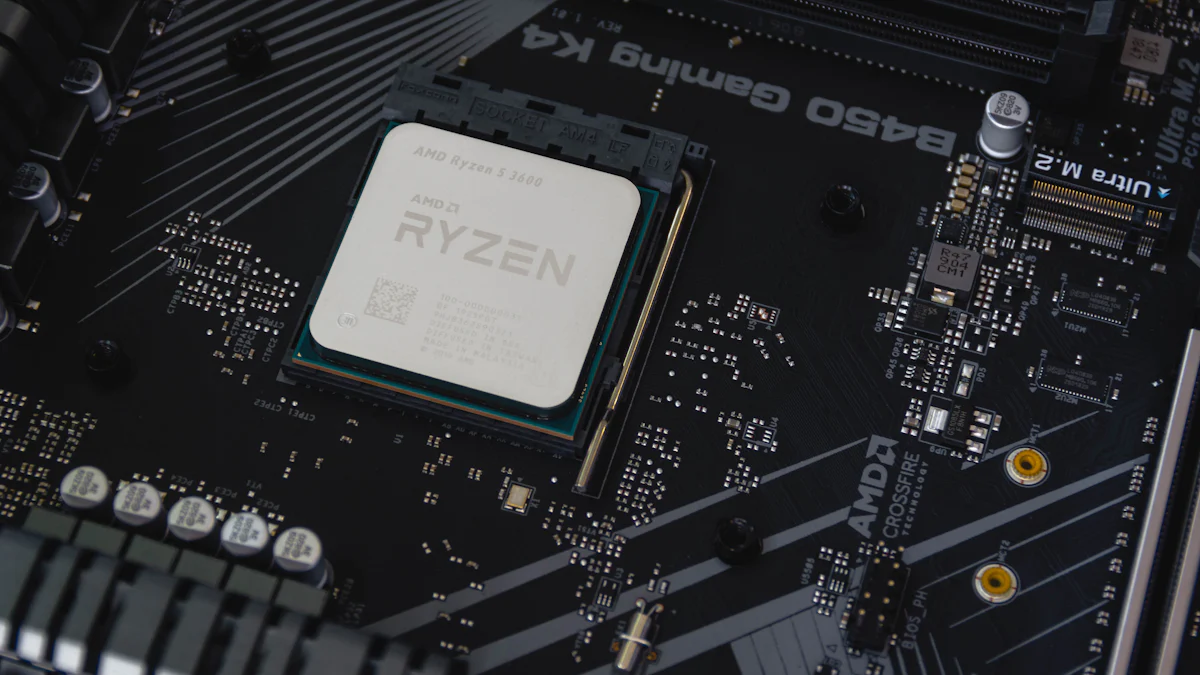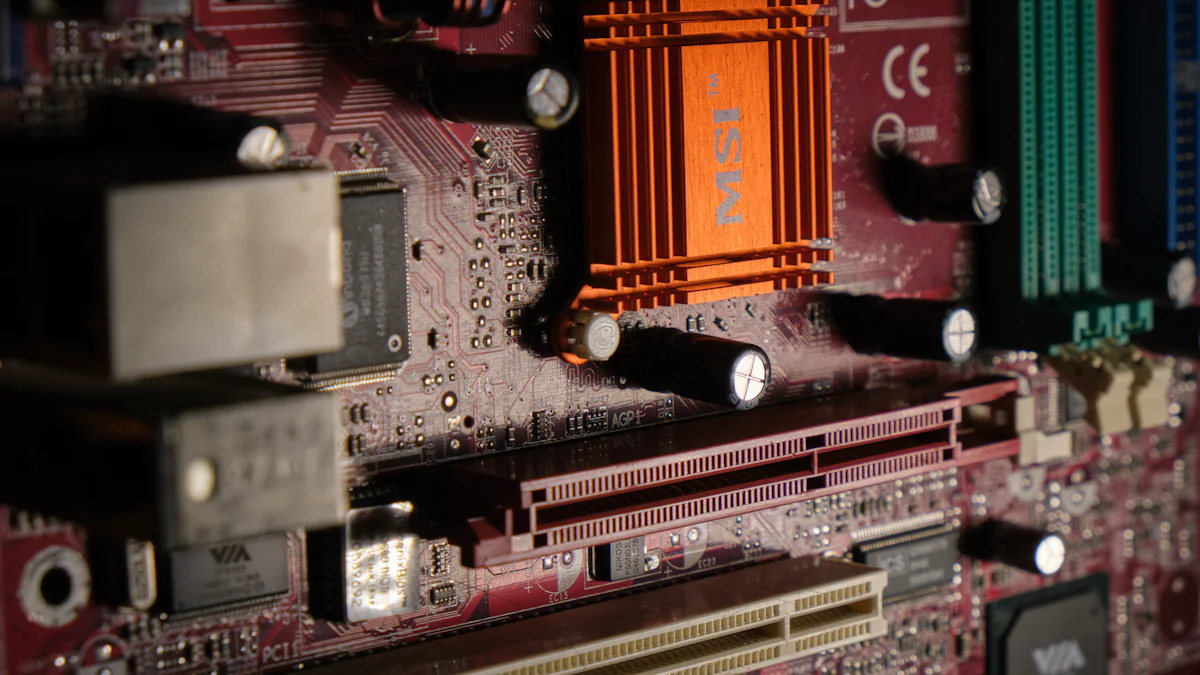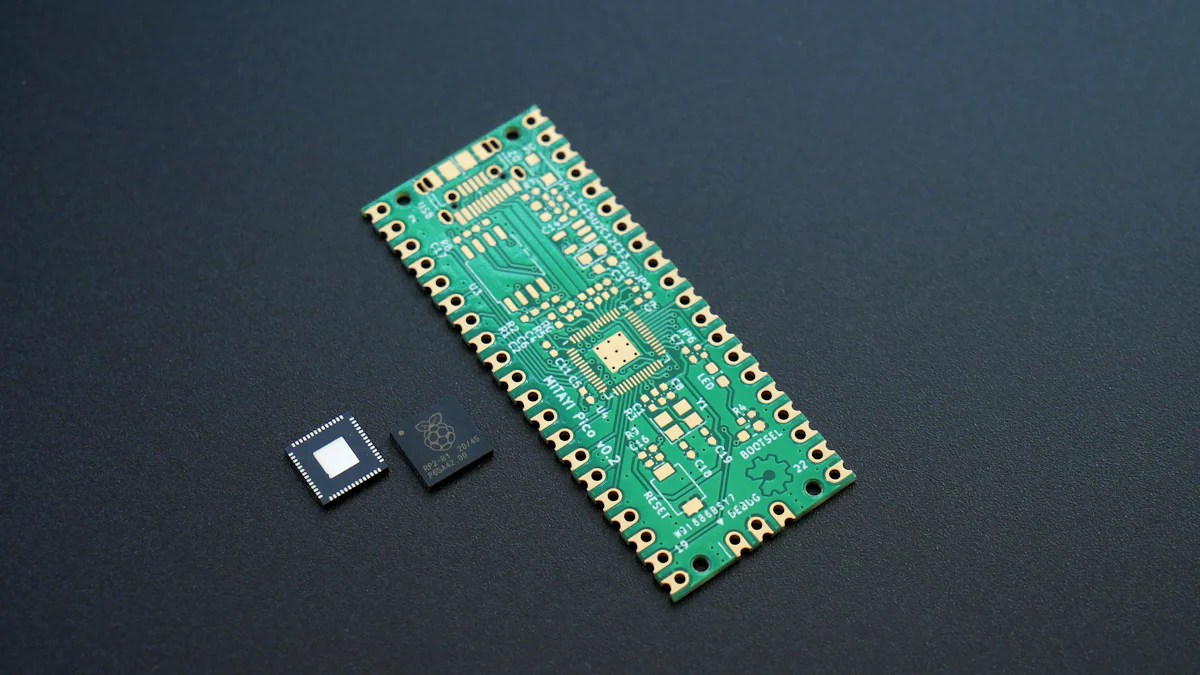
エピタキシャルウエハは、半導体業界において重要な役割を果たし、重要な利点と注目すべき課題の両方を提供します。 これらのウエハは、電子機器やフォトニクス用途に欠かせない高品質の基板を提供することで、デバイス性能を向上させます。 電気的特性および装置効率を改善する能力はそれらに高度の電子工学で必要とさせます。 しかし、エピタキシャルウエハの生産には、複雑なプロセスと高価な機器が組み込まれており、製造コストが上昇しています。 このコスト要因は、特に価格に敏感な市場での採用を制限することができます。 これらの課題にもかかわらず、エピタキシャルウエハの需要は成長し続けています。現代の電子機器の高精度と効率性の必要性によって駆動されます.
要点
- エピタキシャルウエハは、電気的特性と効率性を向上させる高品質の基質を提供することで、半導体デバイス性能を向上させます.
- エピタキシャルウエハのカスタマイズにより、メーカーは特定の用途に合わせ、高度な技術で最適な性能を確保することができます.
- 利点にもかかわらず、エピタキシャルウエファーの高い生産コストは、価格に敏感な市場での採用を制限することができます.
- 製造プロセスの複雑さは、高品質のエピタキシャルウエハの供給を抑制することができる専門的専門知識を必要とします.
- エピタキシャルウエハは、パワーエレクトロニクス、光エレクトロニクス、および5Gや量子コンピューティングなどの新興技術における用途に不可欠です.
- 一貫した材料の品質と長期的安定性により、エピタキシャルウエハは、耐久性のある半導体デバイスに信頼性の高い選択肢となります.
- 微細化・効率的な電子部品の需要が高まるにつれて、エピタキシャルウエハは今後も技術の進歩に重要な役割を果たしていきます.
エピタキシャルウエファーの理解

Definition and Composition
エピタキシャルウエハは、現代の半導体技術のバックボーンとして機能します。 基質ウエファーで育つ半導体材料の薄く、結晶層から成ります。 エピタキシーとして知られるこのプロセスは、層の結晶構造が基質と一致することを保障しま、良質、欠陥なしの表面に終ります。 エピタキシャルウエハで一般的に使用される材料は、シリコン(Si)、ガリウムアルセニド(GaAs)、ガリウム窒化物(GaN)、インジウムリン化物(InP)、炭化ケイ素(SiC)を含みます。 各材料は、高電子モビリティや熱伝導性などの特定のアプリケーションに匹敵するユニークな特性を提供します.
エピタキシャル層の純度および構造の均等性は高度の電子およびフォトニクス装置のためにそれを理想的にします。 優れた基質を提供することにより、エピタキシャルウエハは、LED、MEMS、RFデバイスなどのコンポーネントの性能と信頼性を高めます。 これらのウエハは、最先端技術の開発に不可欠である高効率半導体層の製造に不可欠です.
電子機器の役割
エピタキシャルウエファーは、幅広い用途に基礎基材として機能することで、エレクトロニクス業界において重要な役割を果たしています。 集積回路、トランジスタ、ダイオード、太陽電池の製造に不可欠です。 パワーエレクトロニクスでは、エピタキシャルウエハは、デバイスを高温や電圧で効率的に動作させ、電気自動車や再生可能エネルギーシステムに不可欠です.
エピタキシャルウエファーの需要は、消費者向け電子機器、IoT技術、AI主導のソリューションの進歩によって、上昇し続けています。 これらのウェーハは、電子部品の小型化をサポートし、小型化、より効率的なデバイスの作成を可能にします。 光電子工学の領域では、エピタキシャルウエファーは、高性能LED、レーザーダイオード、フォトデテクターの生産に不可欠であり、エネルギー効率の高い照明ソリューションおよび通信技術の成長に貢献します.
エピタキシャルウエハは5Gインフラと量子コンピューティングの開発にも大きな役割を果たしています。 高品質で欠陥のないレイヤーを提供する能力は、半導体デバイスの電気特性を高め、要求の厳しいアプリケーションで最適な性能を保証します。 エレクトロニクス業界が進化し続けている中、エピタキシャルウエハはイノベーションと技術の進歩の礎を残します.
エピタキシャルウエファーの長所

Enhanced Performance
エピタキシャルウエハは、半導体デバイスの性能を大幅に向上させます。 効率的な電子モビリティを確保する高品質の基質を提供することで、電気的特性を向上させます。 パワー半導体などの用途では、より高い電圧や温度でデバイスを動作させる必要があるため、この改善が不可欠です。 エピタキシャルウエハの電動特性を強化し、エネルギー変換と管理システムの優れた性能を実現します.
電気的特性の改善
エピタキシャル層の純度と構造の均等性は、電気特性の改善に貢献します。 これらのウェーハは、高度な技術に不可欠である高効率半導体層の製造に不可欠です。 無線周波数(RF)装置では、エピタキシャルウエファーの優秀な電子移動性の質は高速操作および信号の性能を促進します。 高度な無線通信とレーダーシステムに欠かせない機能です.
デバイス効率の向上
エピタキシャルウエハは、電子伝達を強化する欠陥のない表面を提供することでデバイス効率を高めます。 この効率は、高度なディスプレイや照明ソリューションのために、高効率と明るさレベルが重要である発光ダイオード(LED)で特に有益です。 高性能半導体層を支えるウェーハの能力は、最先端技術の開発に不可欠です.
カスタマイズ
エピタキシャルウエファーは、メーカーが特定のアプリケーションにそれらを調整できるように、重要なカスタマイズ機会を提供します。 設計の柔軟性により、精密な仕様をクリアし、様々な技術の進歩に適性を高めたデバイスの作成が可能になります.
特定用途の調整
製造業者は異なった適用の独特な条件を満たすために表皮のウエファーを合わせることができます。 このカスタマイズは、レーザーダイオードやフォトデテクターなどの光電子デバイスの生産で特に価値があります。 半導体材料の精密な形成を可能にすることにより、エピタキシャルウエハは、発光効率と高出力レーザー出力の最適な性能を保証します.
設計の柔軟性
エピタキシャルウエハが提供する設計の柔軟性により、革新的な半導体デバイスの開発が可能になります。 この適応性は、電子部品の小型化、小型化、より効率的な機器の創出を支援することに不可欠です。 消費者用電子機器や通信などの産業が成長し続け、小型半導体部品エスカレートの需要が高まり、更にエピタキシャルウエハの採用を燃料化.
Quality and Reliability
エピタキシャルウエハは、一貫した材料の品質と長期的なデバイス安定性を提供し、半導体製造の信頼できる選択を提供します。 高品質の基板は、耐久性と効率的な機器の生産を保証します.
一貫した物質的な質
エピタキシャル成長プロセスは、半導体デバイスの信頼性の高い性能のために不可欠である一貫した材料の品質を保証します。 この一貫性は、高精度が必要な集積回路、トランジスタ、およびダイオードの製造において特に重要です.
長期デバイス安定性
エピタキシャルウエハは、半導体コンポーネントの信頼性を高める欠陥のない表面を提供することで、長期的なデバイスの安定性に貢献します。 この安定性は、電気自動車や再生可能エネルギーシステムなどの用途において非常に重要であり、デバイスは長期にわたって効率的に動作しなければなりません.
エピタキシャルウエファーのコンス
コスト
高い生産能力
エピタキシャルウエファーは、製造に必要な複雑なプロセスと高度な機器により、より高い生産コストを削減します。 特殊な設備や熟練した人材を必要としている、精密・制御を要求します。 この複雑性は、代替半導体コンポーネントと比較してコストを上昇させる結果です。 メーカーは、これらのウェーハの品質と性能を確保するため、最先端の技術に投資し、さらに費用を運転しなければなりません.
全体デバイス価格への影響
エピタキシャルウエハの高生産コストは、それらを組み込むデバイスの価格に直接影響を与えます。 コスト感度の高い市場では、これは採用の重要な障壁をポーズすることができます。 エピタキシャルウエハに依存するデバイスは、多くの場合、より広範なオーディエンスへのアクセシビリティを制限するプレミアム価格タグが付属しています。 その結果、メーカーは、エピタキシャルウエファーを自社製品に統合する際に、性能上の利点とコストのインプリケーションのバランスを慎重に検討しなければなりません.
Complexity
製造業の課題
エピタキシャルウエハの製造は、エピタキシープロセスの複雑性のためにいくつかの課題を提示します。 目的の結晶構造を達成することは温度、圧力および化学成分上の精密な制御を要求します。 あらゆる偏差は、ウェーハの品質と性能を損なう、欠陥につながることができます。 この複雑性は、生産プロセス全体で厳格な品質管理対策と継続的な監視を必要としています.
技術的な専門知識 必須
エピタキシャルウエハの生産は、高いレベルの技術的専門知識を必要とします。 熟練した技術者と技術者は、最適な結果を保証するために、エピタキシーなプロセスを監督しなければなりません。 専門的知識のこの要件は、高品質のエピタキシャルウエハを生産することができる施設の数を制限することができます。 その結果、これらのウェーハの供給は、市場での可用性に影響を与える、制約されることがあります.
限られた適用
特定技術への適合性
エピタキシャルウエハは、優れた電気特性と熱安定性を必要とする特定の技術に特に適しています。 パワーエレクトロニクス、光電子工学、高周波デバイスなどのアプリケーションに優れています。 しかしながら、より広い用途の適性は限られています。 すべての半導体アプリケーションは、特定の分野での採用を制限できるエピタキシャルウエハのユニークな特性から恩恵を受けるわけではありません.
より広い使用の制約
エピタキシャルウエハの広範な使用の制約は、コストと複雑さを伴います。 コスト効率を優先する業界は、低価格で十分な性能を提供する代替半導体コンポーネントを選ぶことができます。 さらに、エピタキシャルウエハ生産に関連する技術的な課題は、よりシンプルなソリューションの接尾辞をアプリケーションに採用するメーカーを決定できます。 その結果、エピタキシャルウエファーは特定のコンテキストにおいて重要な利点を提供しながら、そのブロードラーアプリケーションはこれらの要因によって制約されます.
エピタキシャルウエハは、半導体産業の礎石として立ち、驚くべき利点と注目すべき課題の両方を提供します。 それらは改善された電気特性およびカスタム化の選択によって装置の性能を高めます、それらにハイテクな適用のために必要としました。 しかし、その高い生産コストと複雑性は、より広い採用を制限することができます。 これらの課題にもかかわらず、エピタキシャルウエハは、優れた性能と信頼性を必要とする用途に不可欠です。 先進的なエレクトロニクスと再生可能エネルギーに焦点を当てた産業は、技術革新と技術の進歩を推進し続けるため、特に有益なエピタキシャルウエハを見つけるでしょう.
よくあるご質問
再生可能エネルギー分野におけるエピタキシャルウエファーの需要は?
再生可能エネルギーの排出量の上昇は、エピタキシャルウエハの需要を大幅に向上させます。 太陽光発電や風力エネルギーなどの再生可能エネルギー技術は、エネルギー変換と管理を最適化するために、高効率で耐久性のある半導体コンポーネントが必要です。 エピタキシャルウエハは、これらのシステムで使用される高効率光電池および電力電子機器の製造において重要な役割を果たしています。 セミコンダクタリング材料の高品質で薄い層を作るための優れた電気的特性と能力は、再生可能エネルギーソリューションの性能と信頼性を高めるのに理想的です.
エピタキシャルウエハの採用を妨げる課題は何ですか?
いくつかの課題は、エピタキシャルウエハの採用を妨げる。 生産プロセスは厳密なプロシージャを伴い、高価な装置を、高められた製造業の費用に導く要求します。 このコスト要因は、特に価格に敏感な市場での採用を制限することができます。 また、専門施設やノウハウにより、エピタキシャルウエハの限られた供給が課題を捉えています。 また、先進的なエピタキシャル成長技術と材料を開発し、継続的な研究開発の努力を怠った技術ハードルにも遭遇します.
エピタキシャルウエハは、デバイスのパフォーマンスを向上させるにはどうすればよいですか?
エピタキシャルウエハは、効率的な電子モビリティを実現する高品質の基板を提供することで、デバイス性能を向上させます。 パワー半導体などの用途では、より高い電圧や温度でデバイスを動作させる必要があるため、この改善が不可欠です。 エピタキシャルウエハの電動特性を強化し、エネルギー変換と管理システムの優れた性能を実現します.
半導体製造で信頼されるエピタキシャルウエハはなぜですか?
エピタキシャルウエハは、一貫した材料の品質と長期デバイスの安定性により、信頼性が高く評価されています。 エピタキシャル成長プロセスは、半導体コンポーネントの信頼性を高める欠陥のない表面を保証します。 この安定性は、電気自動車や再生可能エネルギーシステムなどの用途において非常に重要であり、デバイスは長期にわたって効率的に動作しなければなりません.
特定の技術に適したエピタキシャルウエハはどのようなものですか?
エピタキシャルウエハは、パワーエレクトロニクス、光エレクトロニクス、高周波デバイスなどの優れた電気的特性と熱安定性を必要とする用途で優れています。 高品質で欠陥のないレイヤーを提供する能力は、半導体デバイスの電気特性を高め、要求の厳しいアプリケーションで最適な性能を保証します.
エピタキシャルウエハは電子部品の小型化にどのように貢献しますか?
エピタキシャルウエハは、より小型で効率的なデバイスの作成を可能にすることで、電子部品の小型化をサポートします。 設計の柔軟性により、消費者電子機器や通信などの業界において重要な革新的な半導体デバイスの開発が可能になります。 これらの産業は成長し続け、コンパクトな半導体コンポーネントのエスカレートの需要は、エピタキシャルウエファーの採用をさらに促進します.
エピタキシャルウエファーは5Gインフラと量子コンピューティングでどのような役割を果たしますか?
エピタキシャルウエハは5Gインフラと量子コンピューティングの開発に大きな役割を果たしています。 高品質で欠陥のないレイヤーを提供する能力は、半導体デバイスの電気特性を高め、これらの高度なアプリケーションで最適なパフォーマンスを保証します。 エレクトロニクス業界が進化し続けている中、エピタキシャルウエハはイノベーションと技術の進歩の礎となりました.
製造業者は特定の適用のためのエピタキシャル ウエファーをカスタマイズする方法か?
製造業者は異なった適用の独特な条件を満たすために表皮のウエファーを合わせることができます。 このカスタマイズは、レーザーダイオードやフォトデテクターなどの光電子デバイスの生産で特に価値があります。 半導体材料の精密な形成を可能にすることにより、エピタキシャルウエハは、発光効率と高出力レーザー出力の最適な性能を保証します.
エピタキシャルウエハを使用して機器の価格設定により高い生産コストはどのような影響がありますか?
エピタキシャルウエハの生産コストが高まり、それらを組み込むデバイスの価格設定に直接影響を与えます。 コスト感度の高い市場では、これは採用の重要な障壁をポーズすることができます。 エピタキシャルウエファーに依存するデバイスは、多くの場合、より広範なオーディエンスへのアクセシビリティを制限するプレミアム価格タグが付属しています。 メーカーは、製品にエピタキシャルウエハを統合する際に、性能上の利点とコストへの影響のバランスを慎重に検討しなければなりません.